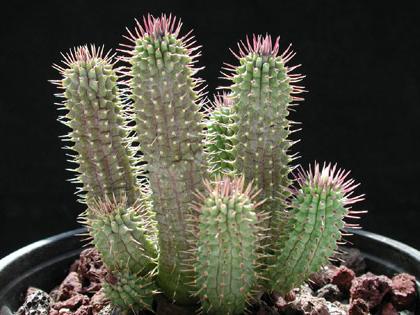Traditional Knowledge of the San of Southern Africa: Hoodia gordonii
Presentation prepared by
Victoria Geingos and Mathambo Ngakaeaja
Working Group of Indigenous Minorities in Southern Africa (WIMSA)
for the Second South-South Biopiracy Summit: "Biopiracy - Ten Years Post Rio"
22-23 August 2002, Johannesburg, South Africa
Introduction
The San of Southern Africa have collected and used the Hoodia gordonia succulent for centuries. WIMSA, a San-owned regional networking organisation, learnt in 2001 that the Council for Scientific and Industrial Research (CSIR) based in Pretoria, South Africa, had identified the active ingredient of the Hoodia. San representatives expressed concern that the CSIR had not consulted them before registering the research on the Hoodia for patenting, and passing the findings of their tests on to the pharmaceutical companies Phytopharm in the UK and Pfizer in the USA. With the assistance of their legal advisor the San entered into negotiations with the CSIR, which resulted in a memorandum of understanding and a benefit-sharing workshop, which
was held recently. A mutual understanding between all stakeholders has been established in this project, the first of its kind, with a firm commitment to sharing the benefits of the future success of the Hoodia patent with the San.
San and the Hoodia
Since 1999 WIMSA has been undertaking a Regional Oral Testimony Collection Project in close co-operation with other San organisations and their support organisations. San themselves conduct, tape and transcribe interviews relating to San history. Over 200 interviews have already been conducted. A number of
male and female respondents refer to the San's knowledge of medicinal plants, and some refer to the Hoodia. San elderly and youth alike have elaborated on the use of the succulent, various species of which grow in sandy or rocky areas in Angola, Namibia, Botswana and South Africa. The ||Anikhwe of northern Botswana feed children who "eat too much" pieces of Hoodia to make them eat
less. If this practice is carried out for longer than three months, the child could die, so Hoodia must be used with caution.
The Hai||om of northern Namibia still use Hoodia sap to treat allergic reactions in the eyes, and to treat severe stomach pain they boil Hoodia pieces in water and drink the brew.The ‡Khomani of north-western South Africa also refer to aforesaid practices. Already decades ago obese members of the ‡Khomani community were eating the Hoodia to slim down. (In the old days people
consumed the plant to meet the requirements of a healthy body whereas today overweight young people do so to slim down to meet the requirements of fashion.) All San communities interviewed - including the !Xun and Khwe who hail from Angola and now live in Schmidtsdrift in South Africa - stated that San hunters suppressed their hunger and maintained their energy levels on their two to three-day hunting trips by eating a slice of Hoodia twice a day. The plant had the same effect on the hunting dogs. Every generation in all San communities has passed the knowledge of the Hoodia on to the next generation
despite such evils as apartheid, which denied the San pride in their culture.
Benefit-sharing

Most San communities enjoy extensive sharing of resources and thus have not withheld their knowledge of the Hoodia and other plants from other ethnic groups. We have come to realise, however, that we need to protect
our intellectual property, and we have taken measures to prevent further exploitation and ensure benefit-sharing amongst our peoples. It was of critical importance to the San that the CSIR acknowledged that our traditional knowledge regarding the Hoodia was the original source leading eventually to the approval of the patent in 1995. At the last WIMSA General Assembly meeting the San delegates appointed the South African San Council to negotiate with the CSIR on behalf of all San in the region. The first round of negotiations between the South African San Council and the CSIR led to the signing of a memorandum of understanding in which the CSIR acknowledges the San's prior intellectual property rights in respect of the Hoodia. The council also
undertakes in the memorandum to negotiate a benefit-sharing agreement to take effect if the plant reaps success in the marketplace. The General Assembly agreed that future benefits deriving from the Hoodia will be shared equally by the San in all countries in which they live, namely South Africa, Namibia, Botswana, Angola, Zambia and Zimbabwe. The San are aware of the complexities arising from the CSIR's association with international commercial
partners, and do not wish to threaten the viability of the planned commercial undertaking. At a workshop on benefit-sharing held recently it was decided that the relationship between the CSIR and the San should involve not only monetary `sharing', but also sharing knowledge. It was also agreed that the
Department of Arts, Culture, Science and Technology (DACST) will provide information to the San on the patenting of all South African plants internationally.
Recommendations
The representatives of WIMSA, the South African San Council and the CSIR present at the above-mentioned workshop recommended the following:
- The Government of South Africa should direct more attention and resources to support indigenous communities who are directly responsible for the creation, maintenance, custodianship and development of their own indigenous knowledge.
- The need for vigorous formal consultation with San should be attended to. This would help to alleviate the perception of the lack of consideration, and to protect indigenous knowledge across regions. The San have for example not yet been consulted by the South African Government with regard to the proposed
laws on biodiversity and benefit-sharing.
- DACST should extend co-operation and support for a regional initiative for awareness-raising, initially by means of a regional conference. The San hope that their recommendations will be taken seriously, and that they will be acted on in the near future.